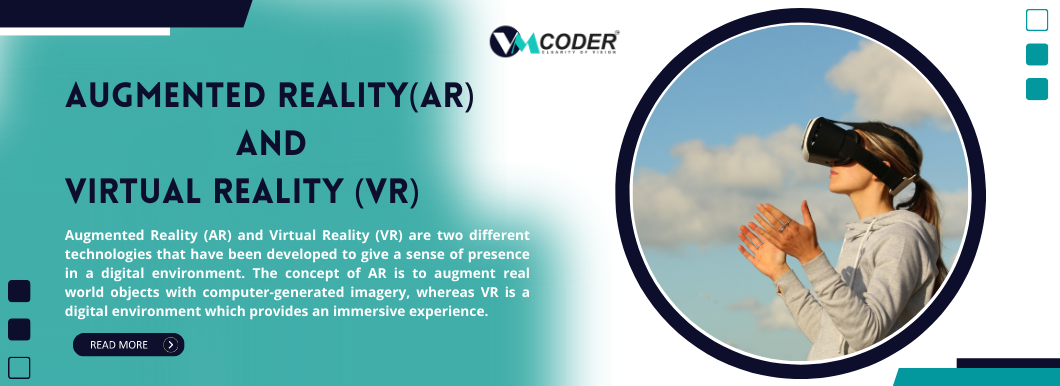Difference between Augmented Reality and Virtual Reality
What is Augmented Reality (AR)?
Augmented reality (AR) is a computer-generated addition to the real world. It is the perception of a user who sees their surroundings with the help of technology such as a smartphone or tablet.
The term was coined in 1965 by Jaron Lanier and is often described as being a combination of a person’s perception of their environment, computers and other electronic devices, and hypermedia technologies.
Augmented reality has been used in games, virtual training systems, simulations, and also in advertising.
Augmented reality (AR) is a computer-generated sensory experience that enhances some aspect of real life. AR technology is used in many areas of science, engineering and business.
Augmented Reality is a computer-generated sensory experience that enhances some aspect of real life. For example, you can hold up your iPhone and see the city streets around you displayed on the screen, or see a 3D model of your car on the dashboard. The idea is to take advantage of the vast amounts of relevant information available online and use it to enhance our perception and awareness of what we are seeing in the real world around us.
What is Virtual Reality (VR)?
Virtual reality is a computer technology that creates a simulated environment using computer hardware, software, electro-mechanical devices, sensors and displays. Within this simulated environment, users can interact with this environment in a variety of ways.
Virtual reality is sometimes described as an experience incorporating visual and auditory senses which can recreate a user's surroundings in virtual space. It has been defined as "a computing process that allows the creation of a simulated or artificial sensory experience using computers". The term was coined by Jaron Lanier in 1996.
Virtual reality is generally categorized into three different types of immersive technologies: passive (where the user perceives their real life location and surroundings), active (where the user moves their physical body within the virtual world) and mixed reality (where both real world objects are present within the virtual world).
Virtual reality technology relies on many components and has become an emerging trend in engineering research.
Difference Between Augmented Reality (AR) vs Virtual Reality (VR)
Augmented reality (AR) is a live direct or indirect view of a physical, real-world environment whose elements are augmented (or supplemented) by computer-generated images. The meshing of real and virtual elements into a coherent experience is known as a mixed reality. The synthesis of real and virtual elements into a coherent experience is called voxelization.
Virtual reality (VR), also known as immersive VR, is an experience taking place within a simulated, interactive three-dimensional environment that can be experienced either through one's own eyes or through special VR devices such as virtual reality headsets. Immersive VR systems that use head mounted displays to display virtual images to the user generate the illusion of perceiving events or objects outside one's physical presence; this differs from augmented reality systems which do not fully replicate the external world.
The first thing that you need to know about Augmented Reality and Virtual Reality is that they are two different things.
Augmented Reality is a technology that overlays computer-generated information on a user's view of reality. It is like a hologram or a transparent window that you can look through without moving your head. In contrast, Virtual Reality (VR) is a technology that simulates an environment especially for the purpose of creating realistic images in the user's mind by using special equipment and software.
The difference between these two technologies lies in their usage and purpose. While AR uses virtual objects to enhance real life, VR uses real-life objects to create virtual worlds. AR is used more commonly in gaming applications where developers build environments where players can see computer-generated objects overlaid on top of the real world while VR is more common in movies and video games where developers use real-world locations as backdrops for their games or stories.
How does AR Works?
Augmented reality (AR) is a phenomenon where the real world is made more real through computer-generated imagery. It can be used to overlay virtual objects into the physical world and can be experienced through special glasses or headsets.
The basic concept of augmented reality is that you see an image on your screen, then move your hand to touch it. However, there are other technologies that are making this experience much more immersive.
Augmented reality works by overlaying computer-generated information on top of real-world views when looking at an object or scene. The user can then interact with this information as if it were an actual real object or person. For example, you might see your car in the distance and then zoom in on it to find out more about its engine performance or fuel consumption.
How does VR Works?
Virtual reality (VR) is a technology that uses virtual images to create a simulated environment. It has been used in gaming, film and television, and is now being used for other purposes such as training and education.
Virtual reality takes place in the virtual world where you are part of the story. To use it you need to wear a headset or glasses with lenses that block out the real world and show you the virtual world instead. This makes your eyes focus on an image that appears to be real but isn't really there. The headset displays images of things around you, like scenery or other people's faces, so you feel like they are really there even though they are not really there.
Virtual reality headsets usually have two cameras which track your head movement so the computer knows where to put images on screen while also allowing you to look around naturally without moving your head too far away from center position. The computer can also display different images based on where your eyes go so you don't feel like something is missing when looking around objects in front of you.
How AR and VR work together?
Augmented reality (AR) is the use of digital technology to superimpose computer-generated images, data or information over a user's view of the real world. The term "augmented" refers to the additional information that can be presented to the user, which may be useful or interesting.
Virtual reality (VR) is an interactive computer-generated simulation that can replicate a user's physical presence in a virtual and /or real environment. In VR, users are able to manipulate objects and interact with virtual environments.
When AR and VR are combined, it creates a new experience for the user where they can see their surroundings in an augmented way, but also interact with those surroundings in an immersive way such as walking around them and looking at things up close.
Augmented reality and virtual reality are two different forms of technology that work together to create a more immersive experience.
Augmented reality is a system that superimposes digital information (e.g., computer-generated images or sounds) onto what is seen in the real world. Virtual reality is a system that provides a computer-generated experience of being in another place, with or without human interaction with the virtual world.
AR and VR are both experiencing rapid growth as technology, consumer interest, and industry investment all continue to expand rapidly. The use of these technologies will continue to grow over the long-term because they provide a unique way to engage consumers on multiple levels through their ability to be both physical and virtual at the same time.
Conclusion
Augmented reality (AR) and virtual reality (VR) are two different technologies that have been developed to give a sense of presence in a digital environment. The concept of AR is to augment real world objects with computer-generated imagery, whereas VR is a digital environment which provides an immersive experience.
The two technologies have been used in conjunction with each other for several years now. They can be combined to create more realistic experiences for the user, including gaming, education and training, entertainment and more. However, there are some key differences between the two that need consideration when trying to integrate them into your business.
If you are considering incorporating AR or VR into your business then it’s worth considering how they work together.
Leave a Reply
Your email address will not be published. Required fields are marked *






